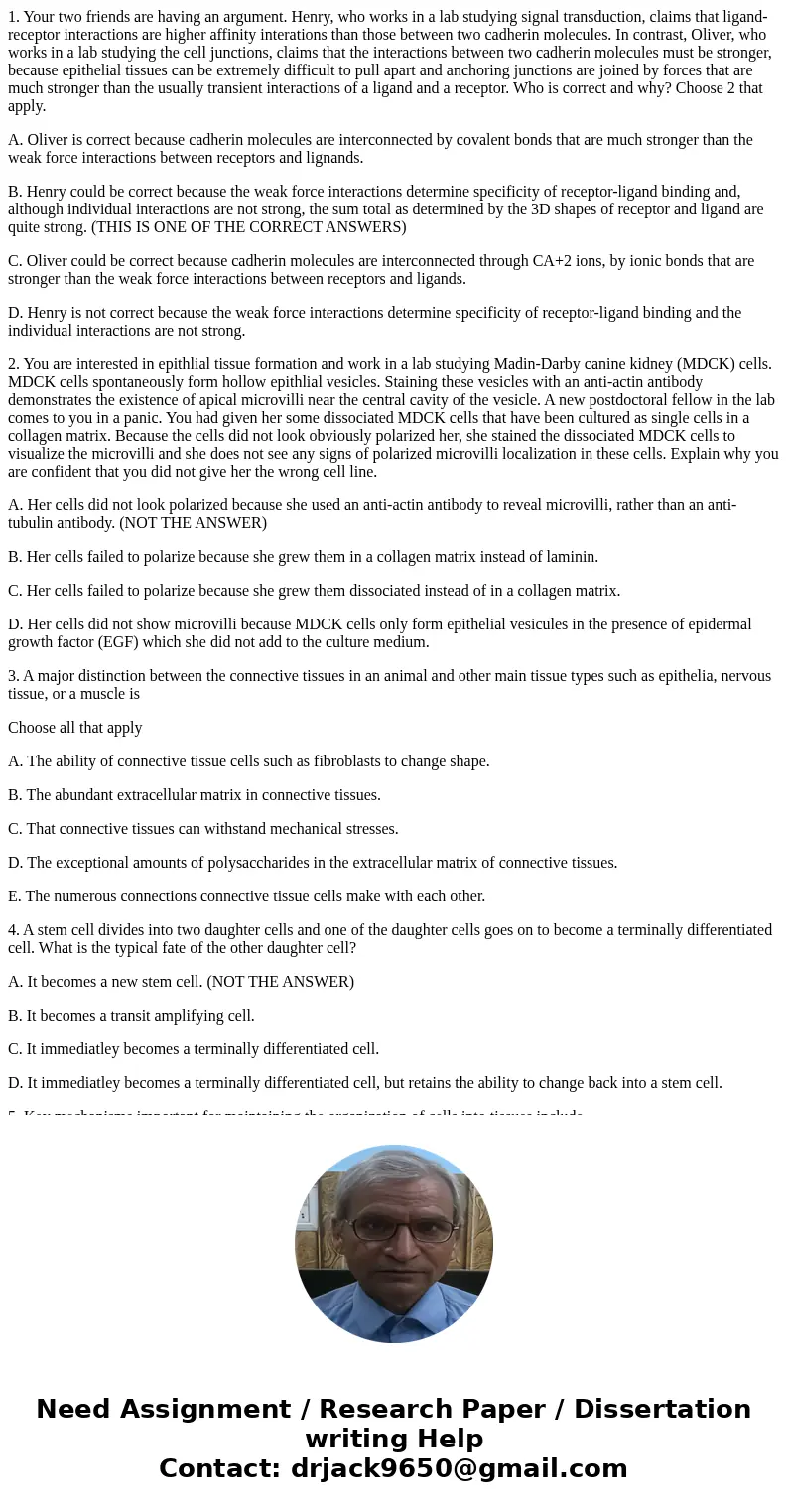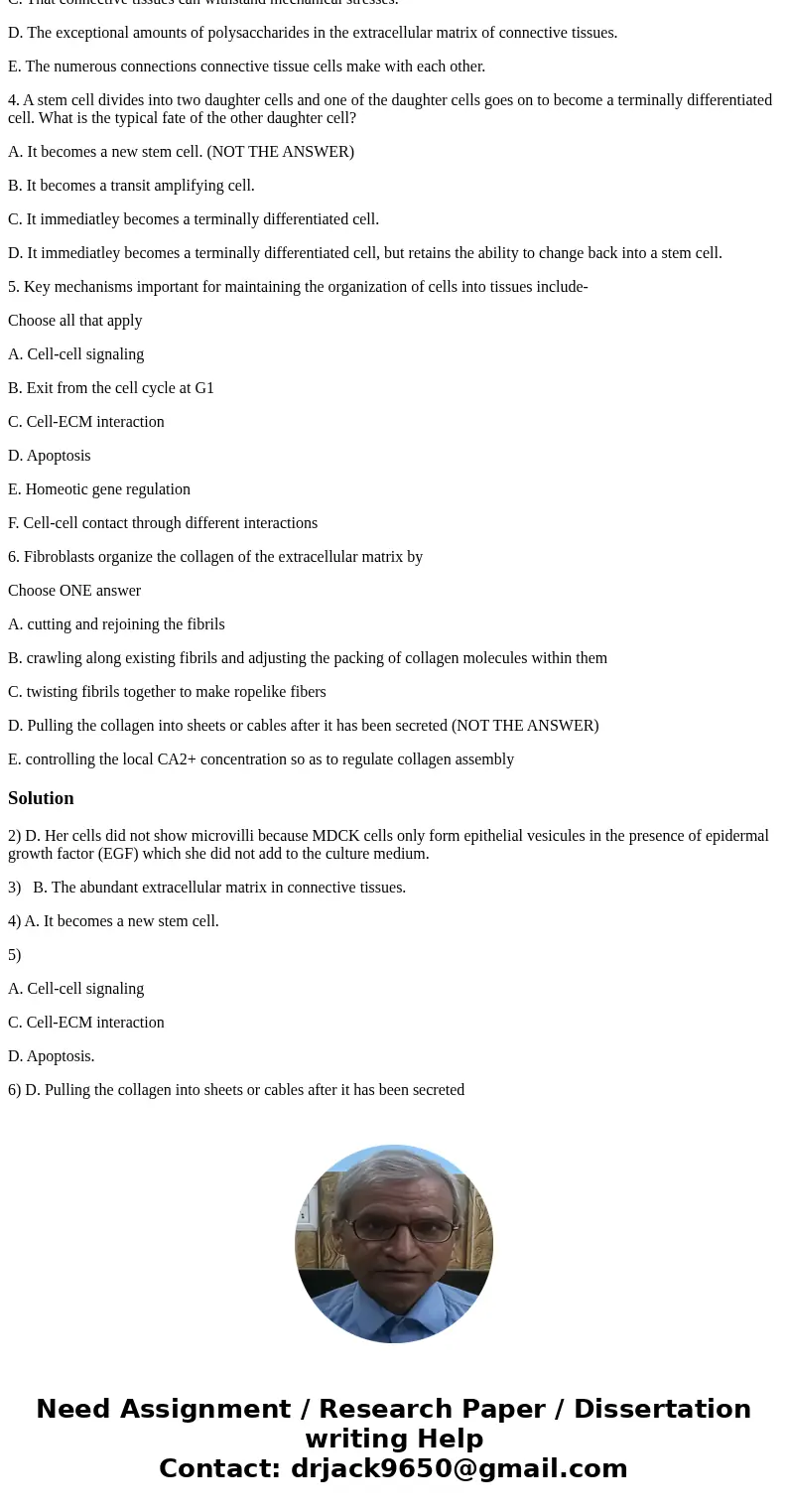1 Your two friends are having an argument Henry who works in
1. Your two friends are having an argument. Henry, who works in a lab studying signal transduction, claims that ligand-receptor interactions are higher affinity interations than those between two cadherin molecules. In contrast, Oliver, who works in a lab studying the cell junctions, claims that the interactions between two cadherin molecules must be stronger, because epithelial tissues can be extremely difficult to pull apart and anchoring junctions are joined by forces that are much stronger than the usually transient interactions of a ligand and a receptor. Who is correct and why? Choose 2 that apply.
A. Oliver is correct because cadherin molecules are interconnected by covalent bonds that are much stronger than the weak force interactions between receptors and lignands.
B. Henry could be correct because the weak force interactions determine specificity of receptor-ligand binding and, although individual interactions are not strong, the sum total as determined by the 3D shapes of receptor and ligand are quite strong. (THIS IS ONE OF THE CORRECT ANSWERS)
C. Oliver could be correct because cadherin molecules are interconnected through CA+2 ions, by ionic bonds that are stronger than the weak force interactions between receptors and ligands.
D. Henry is not correct because the weak force interactions determine specificity of receptor-ligand binding and the individual interactions are not strong.
2. You are interested in epithlial tissue formation and work in a lab studying Madin-Darby canine kidney (MDCK) cells. MDCK cells spontaneously form hollow epithlial vesicles. Staining these vesicles with an anti-actin antibody demonstrates the existence of apical microvilli near the central cavity of the vesicle. A new postdoctoral fellow in the lab comes to you in a panic. You had given her some dissociated MDCK cells that have been cultured as single cells in a collagen matrix. Because the cells did not look obviously polarized her, she stained the dissociated MDCK cells to visualize the microvilli and she does not see any signs of polarized microvilli localization in these cells. Explain why you are confident that you did not give her the wrong cell line.
A. Her cells did not look polarized because she used an anti-actin antibody to reveal microvilli, rather than an anti-tubulin antibody. (NOT THE ANSWER)
B. Her cells failed to polarize because she grew them in a collagen matrix instead of laminin.
C. Her cells failed to polarize because she grew them dissociated instead of in a collagen matrix.
D. Her cells did not show microvilli because MDCK cells only form epithelial vesicules in the presence of epidermal growth factor (EGF) which she did not add to the culture medium.
3. A major distinction between the connective tissues in an animal and other main tissue types such as epithelia, nervous tissue, or a muscle is
Choose all that apply
A. The ability of connective tissue cells such as fibroblasts to change shape.
B. The abundant extracellular matrix in connective tissues.
C. That connective tissues can withstand mechanical stresses.
D. The exceptional amounts of polysaccharides in the extracellular matrix of connective tissues.
E. The numerous connections connective tissue cells make with each other.
4. A stem cell divides into two daughter cells and one of the daughter cells goes on to become a terminally differentiated cell. What is the typical fate of the other daughter cell?
A. It becomes a new stem cell. (NOT THE ANSWER)
B. It becomes a transit amplifying cell.
C. It immediatley becomes a terminally differentiated cell.
D. It immediatley becomes a terminally differentiated cell, but retains the ability to change back into a stem cell.
5. Key mechanisms important for maintaining the organization of cells into tissues include-
Choose all that apply
A. Cell-cell signaling
B. Exit from the cell cycle at G1
C. Cell-ECM interaction
D. Apoptosis
E. Homeotic gene regulation
F. Cell-cell contact through different interactions
6. Fibroblasts organize the collagen of the extracellular matrix by
Choose ONE answer
A. cutting and rejoining the fibrils
B. crawling along existing fibrils and adjusting the packing of collagen molecules within them
C. twisting fibrils together to make ropelike fibers
D. Pulling the collagen into sheets or cables after it has been secreted (NOT THE ANSWER)
E. controlling the local CA2+ concentration so as to regulate collagen assembly
Solution
2) D. Her cells did not show microvilli because MDCK cells only form epithelial vesicules in the presence of epidermal growth factor (EGF) which she did not add to the culture medium.
3) B. The abundant extracellular matrix in connective tissues.
4) A. It becomes a new stem cell.
5)
A. Cell-cell signaling
C. Cell-ECM interaction
D. Apoptosis.
6) D. Pulling the collagen into sheets or cables after it has been secreted


 Homework Sourse
Homework Sourse